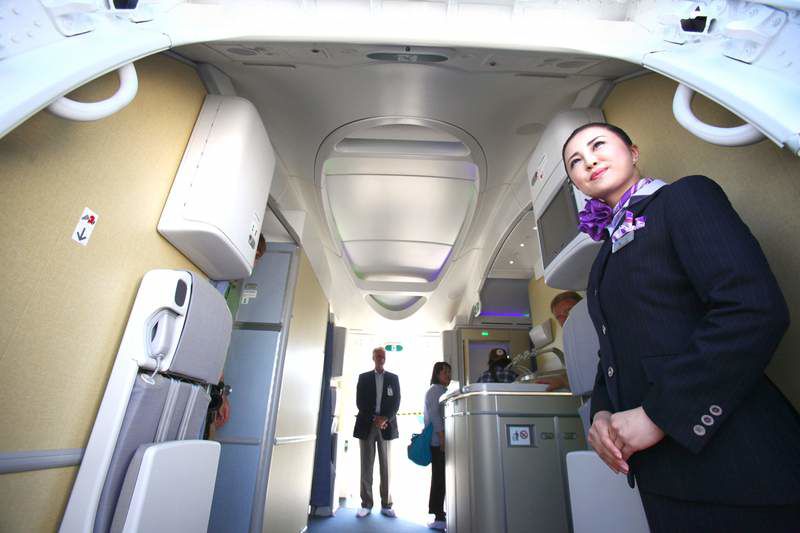Cabin has new look in Boeing Dreamliner
Published 5:00 am Tuesday, August 9, 2011

- Flight attendant Kyoko Kouokawa waits at the door of the plane during the unveiling of the first Boeing 787 destined for use by All Nippon Airways. One of the most noticeable things upon entering the plane is the high ceilings, creating a sense of openness rather than claustrophobia.
SEATTLE — Passengers who board the 787 Dreamliner, now almost ready to fly off to Japan, will find some impressive touches.
Boeing rolled out the first All Nippon Airways 787 for inspection over the weekend, and some of the details and features long promised by Boeing lived up to expectations.
Assuming the Dreamliner gets the thumbs up from the Federal Aviation Administration, Boeing is scheduled to deliver the jet next month.
Don’t expect a total revolution in the airplane experience. It’s the airlines and not Boeing that decide elements such as how much leg room you’ll have.
All Nippon Airways plans to fly the 787 on short-haul domestic routes in Japan, carrying a tightly packed 264 passengers in a plane Boeing advertised as carrying up to 250.
Leg room in economy section is similar to that on today’s U.S. domestic flights.
But looking at the features Boeing was able to change, the interior design should be a hit with passengers.
Immediately on entering, the jet seems different. An entrance atrium with a 10-foot high ceiling gives a sense of space, air and light instead of the usual feeling of claustrophobic enclosure.
ANA has placed a large bar to one side of this entrance, where spirits may be lifted by a row of wine bottles hooked securely into niches on the counter.
Advancing into the cabin aisles, even tall passengers will enjoy lots of headroom, thanks to the design of the stow bins that swivel upward out of the way. Sophisticated lighting in the ceiling, which changes color to suit the phases of flight, adds to the effect of space overhead.
When taking a seat, the most arresting 787 feature is the window.
The windows are big, 30 percent larger than those on current airplanes. Even sitting in the middle seats of the wide cabin — which is configured eight-abreast, 2-4-2, in economy — one can glance sideways and see out the window.
And one of Boeing’s most-touted technical innovations, the ability to darken the windows with the touch of a button, really is cool — so much so, that once a passenger in the window seat gets the hang of the push-button control, he or she will pretty well be compelled to play with what seems like magic.
(It’s science, actually. The opacity of the window, from clear to dark, is controlled electronically. An electric current is applied to a layer of gel sandwiched between two thin pieces of glass, and a chemical reaction causes the window to darken.)
The technology allows the flight attendants, or the passenger in the window seat, to control the light without entirely blotting out the view. Even at the darkest setting, from the window seat one can still see outside, as if looking through very dark sunglasses.
On ANA flights, the toilets reveal a feature you won’t find on U.S. airlines.
They double as bidets, with push-button electronic control of various spray options.
Most of the toilets are regular airline size, but one in the middle of the cabin is double-sized and has a window. For privacy, perhaps more on the ground than at 30,000 feet, that window has both the electronic dimmer and a regular plastic sliding shade.
The first Dreamliner will have a special inaugural flight, likely in October, from Tokyo to Hong Kong. ANA senior executive vice president Mitsuo Morimoto said Saturday that the first regular passenger flights will fly routes from Tokyo to Okayama and to Hiroshima.
He said ANA will take a dozen Dreamliners between now and the end of March and eight in the following 12 months.
After the airline opens those first two domestic Japanese routes, it will configure its next Dreamliners with just 158 seats — a much-less-dense 46 business class seats and 112 economy — to fly long-distance either to Europe or the U.S.
The Dreamliner can fly direct from Japan to the East Coast of the U.S.
Though ANA does not fly to Seattle currently, the 787 could open up that possibility since the jet is smaller than today’s long-range airplanes — such as the 365-seat 777 or the 416-seat 747 — and so can be filled even serving cities with less traffic than destinations such as New York or L.A.






